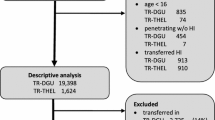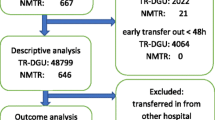Abstract
The outcome performance of the adult patients trauma care in Helsinki University Hospital was compared with a sample of English hospitals. This was a first time such an audit on trauma care was conducted in Finland. Helsinki University Hospital submitted the Trauma Audit and Research Network (TARN, UK) data of adult trauma patients during 1 year period (from 1 September 2004 to 31 August 2005). Patients younger than 16 years were excluded. The outcome performance was assessed by TARN prediction model using the TARN database as reference. There were total of 1,717 patients in Helsinki and 16,774 patients in English hospitals fulfilling the study inclusion criteria, and 1,635 (95.2% of total) eligible patients in Helsinki and 15,269 (91.0% of total) in England were used for analysis. The patients were older and the mean ISS was higher in Helsinki (mean ISS in Helsinki 14 vs. 11 in England). The standardized W statistic (a measure of survival variation from the expected mean, per 100 patients) was + 3.0 (confidence intervals + 2.3 to + 3.8) for Helsinki University Hospital and + 0.2 (confidence intervals –0.1 to 0.4) for English hospitals. These results suggest that the organization of trauma care in Helsinki University Hospital area is more effective in preventing death after trauma in adults than that covering the present sample of English hospitals.
Similar content being viewed by others
References
Nijs S, Broos P. Trauma care systems in Belgium. Injury 2003;34:652–57.
Statistics Finland. Deaths/cause of death/2003. Available at: http://www.tilastokeskus.fi.
Hansen KS, Morild I, Engesater LB, Viste A. Epidemiology of severely and fatally injured patients in western part of Norway. Scand J Surg 2004;93:198–203.
Handolin L, Leppäniemi A, Vihtonen K, Lakovaara M, Lindahl J. Finnish Trauma Audit 2004: current state of trauma management in Finnish hospitals. Injury 2006;37:622–625.
Champion H, Copes W, Sacco WJ, Lawnick MM, Keast SL, Bain LW, Flanagan ME, Frey CF. The major trauma outcome study: establishing national norms for trauma care. J Trauma 1990; 30:1356–1365.
MacKenzie EJ, Rivara FP, Jurkovich GJ, Nathens AB, Frey KP, Egleston BL, Salkever DS, Scharfstein DO. A national evaluation of the effect of trauma-center care on mortality. N Engl J Med 2006;354:366–378.
Peleg K, Aharonson-Daniel L, Stein M, Kluger Y, Michaelson M, Rivkind A, Boyko V, the Israel Trauma Group Increased survival among severe trauma patients: the impact of a national trauma system. Arch Surg 2004;139:1231–1236.
Simons R, Eliopoulos V, Laflamme D, Brown R. Impact on process of trauma care delivery 1 year after the introduction of a trauma program in a provincial trauma center. J Trauma 1999;46:811–815.
Lecky F, Woodford M, Yates D. Trends in trauma care in England and Wales 1989–1997. Lancet 2000;355:1771–1775.
MacKenzie EJ. Review of evidence regarding trauma system effectiveness resulting from panel studies. J Trauma 1999; 47:34–41.
The Trauma & Audit Research Network, Hope Hospital, University of Manchester. [TARN Web site]. Available at: http://www.tarn.ac.uk.
Association for the Advancement of Automotive Medicine. The abbreviated injury scale 1990 revision (98 update). Des Plaines: Association for the Advancement of Automotive Medicine, 1998.
Baker SP, O’Neill B, Haddon W, Long WB. The injury severity score: a method for describing patients with multiple injuries and evaluating emergency care. J Trauma 1974;14:187–196.
Bouamra O, Wrotchford A, Hollis S, Vail A, Woodford M, Lecky F. A new approach to outcome prediction in trauma: a comparison with the TRISS model. J Trauma 2006;61:701–710.
Hollis S, Yates DW, Woodford M, Foster P. Standardised comparison of performance indicators in trauma: a new approach to case-mix variation. J Trauma 1995;38:763–766.
Skaga NO, Eken T, Steen PA. Assessing quality of care in a trauma referral center: Benchmarking performance by TRISS-based statistics or by analysis of stratified ISS data? J Trauma 2006;60:538–637.
Patel HC, Bouamra O, Woodford M, King AT, Yates DW, Lecky FE. Trends in head injury outcome from 1989 to 2003 and the effect of neurosurgical care: an observation study. Lancet 2005;366:1538–1544.
Author information
Authors and Affiliations
Corresponding author
Rights and permissions
About this article
Cite this article
Handolin, L., Leppäniemi, A., Lecky, F. et al. Helsinki Trauma Outcome Study 2005: Audit on Outcome in Trauma Management in Adult Patients in Southern Part of Finland. Eur J Trauma Emerg Surg 34, 570–576 (2008). https://doi.org/10.1007/s00068-007-7129-y
Received:
Accepted:
Published:
Issue Date:
DOI: https://doi.org/10.1007/s00068-007-7129-y




